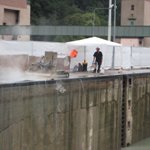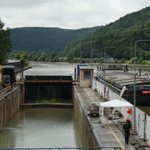Lightweight Aqua Cutter Solution For German Lock
 As part of Germany’s WSV and the Bundersministerium’s strategy to upgrade its locks on the River Neckar, hydrodemolition techniques are being employed at the Guttenbach lock where weight loadings are critical to prevent badly cracked lock walls from collapsing.Hydrodemolition specialist Luckei Betonfrästechnik based in Bendorf, Germany, was awarded the contract for the concrete removal, opting to use its Aqua cutter HD RA robot from Sweden’s Aquajet Systems – weighing just 1700 kg – to remove poor quality and cracked concrete.
As part of Germany’s WSV and the Bundersministerium’s strategy to upgrade its locks on the River Neckar, hydrodemolition techniques are being employed at the Guttenbach lock where weight loadings are critical to prevent badly cracked lock walls from collapsing.Hydrodemolition specialist Luckei Betonfrästechnik based in Bendorf, Germany, was awarded the contract for the concrete removal, opting to use its Aqua cutter HD RA robot from Sweden’s Aquajet Systems – weighing just 1700 kg – to remove poor quality and cracked concrete.
 Located on Germany’s River Neckar, the twin Guttenbach Locks were first built in 1939 with a second lock being added in 1955. The middle wall separating both locks and also built in 1939 is just 1.2m wide. With excessive cracking on both sides of the lock walls, weight loadings was a critical factor in determining the method of removing the concrete slab across the full 1.2m width.
Located on Germany’s River Neckar, the twin Guttenbach Locks were first built in 1939 with a second lock being added in 1955. The middle wall separating both locks and also built in 1939 is just 1.2m wide. With excessive cracking on both sides of the lock walls, weight loadings was a critical factor in determining the method of removing the concrete slab across the full 1.2m width.
The compact and versatile HD Robot Arm is proving ideal for working on the 1.2m wide strip. It features Aquajet’s improved EDS cutting head which keeps the set distance from the nozzle to the surface independent of the selected lance angle: optimizing the removal rate and saving energy. The system also has no electric cables or sensors at the front, eliminating the risk of malfunction due to moisture. All movements are hydraulically manoeuvred by remote control, a safe distance from the unit. No manual adjustments or use of tools is required to position the robot arm.
Together with the robot, Luckei is operating a high pressure Power Pack with a capacity of 250 l/ min of water at 1000 bar. Water is taken from the river and filtered to ensure performance is not affected by dirty water. Once used, the water is again filtered and returned to the river. A temporary gate barrage has been placed across the upstream end of the lock closest to the river bank and water pumped out to provide a dry lock for Luckei to prepare the 9.50m wall. Once re-concreted and additional strengthening completed with the installation of 20m deep pre stressed anchors along both sides of the lock, new gates will be installed for the lock to resume normal duties.
The River Neckar is 367 km long and forms a major tributary to the River Rhine which it joins at Mannheim discharging an average 145m³/s of water into the Rhine; making it the fourth largest tributary and Germany’s tenth largest river. It is navigable for cargo ships up to the river port of Plochingen, some 200 km upstream from Mannheim and features 27 locks dropping the river from 247.32 m to 86.50 m. With barge traffic using the Guttenbach Lock every 10 – 15 minutes between 7 am and 10 pm, plans are underway to increase the length of the lock from 100 m to 130 m in readiness for the new generation of longer barges. Main contractor for the Guttenbach Lock project is Echterhoff GmbH & Co Kg and consulting engineer is Glass Bauunternehmung GmbH.






